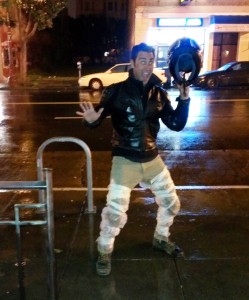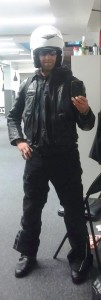|
Don’t forget your rain gear! |
How about a weather report!
Ready? Here it is:
It’s winter time. In winter it rains. It gets dark early. Winds kick up. There are more road hazards. A different style of riding is required. Different gear is required. Good decision-making is mandatory.
For some of you, riding in the rain is something you’re not comfortable with and that’s totally cool. Refer to rule #1: “The moment you exceed your comfort zone on a motorbike you’re asking for trouble.” But if you are ready to try it or are already doing it there are a few things I want you to know.
I think it is safe to say, the biggest fears about winter-time riding are lack of traction, becoming less functional in the cold/wet conditions and not being recognized by other motorists.
Here is a laundry list that will help you stay prepared:
Weather
Check weather reports often. Bay Area winters have these nice extended dry periods and we get accustomed to them. Next thing you know you’re at work and it begins raining. If you don’t have some rain gear with you getting home is NOT going to be fun.
Solution: Either leave a pair of cheapo roll-up rain pants at work or make sure to have some with you when rain is on the report.
Gear
It is a good idea, when making purchases for your riding needs, to consider what constitutes an “investment” in your safety and comfort vs. cool stuff that you really, really want. Let us agree that a smoke colored windscreen for your sportbike or a limited edition Valentino Rossi helmet do not count as an investment. If, like most people, you have a limited budget for motorcycling might I suggest that you pick a fair mix between the instant gratification spending that truly is a big part of the fun of it all and quality safety gear, which can potentially allow you to keep on having fun even after a little spill? Example: my SIDI boots. I really did not want to spend $350 on boots at that time. But I knew they were going to serve me well over several years and that in the end they would not only keep me warm and dry in the wet months and protect the feet and ankles I love so much but also save me money in the end. ‘Nuf said?
Outerwear: I have never owned a full rain suit such as the popular Aerostich brand. They seem pretty awesome but I typically cannot find a spare thousand bucks in my motorcycle apparel budget for one of those beauts. Frankly, for my commuting needs that feels like overkill and I’ve never taken extended road trips in lousy weather. So before you invest decide if a full suit is right for you.
For commuting and general local needs I have managed just fine with thoughtful layering.
Here’s my “special Bay Area layering system”:
Above the waist from inside, out: tee shirt + long sleeve Dri-Fit or smart wool top, hoodie and/or light insulated zip-front warm up jacket, then leathers on top; perhaps a water and windproof shell over that if it’s really rainy. From bare chest that’s about 5 layers, thinnest on the inside. I have a rain-specific riding jacket too but I tend to use that less. That’s just my preference.
Below the waist: I either wear leather riding pants which keep rain and cold out quite well for short to medium duration trips or I have a fantastic pair of Olympia brand weather pants made of ballistic Cordura fabric and 3M reflective material. They have hip & knee armor, come with a zip-out insulated liner, have well-placed pockets and they are super easy to get on and off. Several other companies make a similar product. Mine cost me about two hundred bones a few years back and they still look as good as new other than the lint that gets stuck to the Velcro near the boots.
Stop by your local retailer and try a pair or three on. When it’s wet out you’ll be so glad you did.
Additionally, I sometimes wear long underwear bottoms or running tights under my regular pants or rain pants when it’s cold out.
Boots: I love my SIDI Gor-tex boots (mentioned above). They keep me warm and dry and aren’t too bad when walking around for awhile even if they are a bit clunky. I got ‘em three seasons ago for about $350 and knew that they were a great investment (see “investment” above).
But you don’t need to purchase motorcycle-specific boots, particularly for local riding. I have another pair of leather stompers that work well for most conditions.
Note: if you have lace-up boots please double knot them AND tuck those loops in. It is not unheard of to get loops caught in your gear shifter. Yes, that has happen to me and it’s a creepy experience.
No matter what, do not ride around in your hip Chuck Taylors when the weather is bad. That’s just dumb. Get some over-the-ankle protection when the conditions are poor as your chances of dropping the bike are higher regardless of how good a rider you’ve become.
Gloves: Get a pair of Gor-tex or other rain-resistant insulated gloves for winter time. You’ll be sooo glad you did. The kind where the material in the fingertips is sewn into the outer glove is best. If you’ve ever tried to re-insert damp glove fingers into their proper holes you know what a pain in the butt it is. (The key is to use a chopstick by the way.) My gloves also have a little rubber wiper blade on the thumb side of the index finger; they work decently for wiping your face shield off while riding. Sometimes I go through a couple pairs of gloves on really wet days so it’s not a bad idea to have more than one pair.
Tip: Carry a rag with you! You’re always going to need to wipe something down in winter, whether it’s your bike seat, your head lamp, mirrors or to dry your hands before putting the gloves on.
Why layers? San Francisco microclimates are a special thing, aren’t they? Some places you go are warmer than others. Some buildings you go into are warmer than others. When it comes to cold and wet conditions I’m kind of a wuss. I love having the option to unload some layers while retaining others. If you remove it you can always put it back on. It’s been working for me for years. The biggest challenge is finding a large enough space to drop it all when you arrive at your destination.
|
Terrible selfie…wearing rain gear. Helmet goes down to full-face out there. |
Final word on gear…Talk to the folks at the shops about the right apparel for your needs. They are riders too, they know what works and will help you with sizing so pick their brains! A list of our favorite shops is on the “Resources” page at https://monkeymotoschool.com/links/
The ride
Mantra: Every time you get on your motorcycle or scooter say these words to yourself: “I WILL make it to my destination! Too many people love and care for me and being a cripple would really suck.”
To add to your wet weather safety here are a few solid riding tips:
First, when it’s wet out practice using your brakes on a quiet street or in a parking lot because braking in the wet is different than braking on dry roads. A lot different! Start off gently and get progressively more aggressive until there are no surprises. Initially, you may experience your brakes locking up or tires skidding but this will help you to know your bike’s capabilities in adverse conditions and more importantly, it will allow you to build muscle memory in order to react precisely in the event of slippage. You should know how your brakes and tires perform on slippery surfaces before you need to use them in those conditions in traffic.
When the pavement is damp or wet leave more buffer room behind and in front of other vehicles than you would in dry conditions and scan the spaces in between moving cars for potential exit lanes. Often, riding in between cars (lane splitting) is the safest place for you to reside in a sticky situation. Stop fixating on painted lane markers and begin seeking out open spaces wherever they may be! LANE SPLITTING IS LEGAL IN THE STATE OF CALIFORNIA. Learn how to do it properly by taking advanced motorcycle riding lessons from youknowwho!
Make yourself known to other motorists. This is 24/7, 365 in all conditions of course. Use all of the tools at your disposal to be seen and heard. That means well-timed horn toots, throttle blips, flashing high/low beams, weaving within your lane and it means assertive body signaling. You must create and maintain space for yourself. It begins by letting the cagers know that you’re there.
Things in the road that can ruin your day when it’s wet: Manhole covers, for example, are like a slip n slide if you hit them at an angle and your speed isn’t steady. A few years back in pouring rain I came to a stop for a red light. When I applied the front brake the front tire happened to be on top of a manhole cover. Next thing I knew I was on my side. Fortunately, it was mostly my pride that was hurt. DPW reflective road paint is deceptively slippery. And of course streetcar rails are nasty in the rain. Be sure to cross the tracks with steady speed at a 45 degree angle!
Other hazards: those large metal construction plates, oil and coolant spills, gravel, sand and wet leaves, bumps, potholes…
So how do you drive on very slippery surfaces?
Carry constant speed. Do NOT accelerate sharply on wet roads. Maintain very even throttle or in some instances gliding is even recommended. Have you ever crossed the metal drawbridges at 3rd and 4th Streets by AT&T Park in San Francisco? Try it in the rain!
In the event of an accident
If you do drop your bike keep your wits about you. If you are in traffic when it happens you’ll want to move the bike out of the way if that is at all possible. If you cannot do it or can’t do it alone start directing people to help you. Bystanders are typically eager to help when they can but they themselves panic and don’t really know what to do. Be calm and clear and tell them how they can assist. If another vehicle is involved do not forget to obtain the driver’s information no matter how “ok” you think you are. Get witness info. as well. If you don’t need it later that’s great but if you do and don’t have it that is quite unfortunate for you.
If you are not sure what your medical condition is following an accident or cannot move on your own do not allow yourself to be moved by non-medical professionals. Just ask people to divert traffic until official help arrives.
In case of Apocalypse
You’re on a bike. Just ride through it! But you might want to have a spare gas container and some snacks along.
Thanks for reading! I hope you found this info. helpful. Happy and healthy holidays to all of you!
Your pal in two-wheeled fun,
Evan Arkush
Chief Monkey
Monkey Moto School

